[English] 日本語
 Yorodumi
Yorodumi- PDB-1seb: COMPLEX OF THE HUMAN MHC CLASS II GLYCOPROTEIN HLA-DR1 AND THE BA... -
+ Open data
Open data
- Basic information
Basic information
| Entry | Database: PDB / ID: 1seb | ||||||
|---|---|---|---|---|---|---|---|
| Title | COMPLEX OF THE HUMAN MHC CLASS II GLYCOPROTEIN HLA-DR1 AND THE BACTERIAL SUPERANTIGEN SEB | ||||||
 Components Components |
| ||||||
 Keywords Keywords | COMPLEX (MHC II/PEPTIDE/TOXIN) / HISTOCOMPATIBILITY ANTIGEN / MHC II / SUPERANTIGEN / ENTEROTOXIN PEPTIDE / TOXIN / COMPLEX (MHC II-PEPTIDE-TOXIN) COMPLEX | ||||||
| Function / homology |  Function and homology information Function and homology informationregulation of interleukin-4 production / regulation of interleukin-10 production / myeloid dendritic cell antigen processing and presentation / antigen processing and presentation of endogenous peptide antigen via MHC class II / autolysosome membrane / regulation of T-helper cell differentiation / positive regulation of CD4-positive, CD25-positive, alpha-beta regulatory T cell differentiation / MHC class II receptor activity / positive regulation of CD4-positive, alpha-beta T cell activation / antigen processing and presentation of peptide or polysaccharide antigen via MHC class II ...regulation of interleukin-4 production / regulation of interleukin-10 production / myeloid dendritic cell antigen processing and presentation / antigen processing and presentation of endogenous peptide antigen via MHC class II / autolysosome membrane / regulation of T-helper cell differentiation / positive regulation of CD4-positive, CD25-positive, alpha-beta regulatory T cell differentiation / MHC class II receptor activity / positive regulation of CD4-positive, alpha-beta T cell activation / antigen processing and presentation of peptide or polysaccharide antigen via MHC class II / positive regulation of kinase activity / positive regulation of memory T cell differentiation / positive regulation of T cell mediated immune response to tumor cell / positive regulation of monocyte differentiation / inflammatory response to antigenic stimulus / CD4 receptor binding / intermediate filament / T-helper 1 type immune response / transport vesicle membrane / Translocation of ZAP-70 to Immunological synapse / Phosphorylation of CD3 and TCR zeta chains / polysaccharide binding / negative regulation of type II interferon production / humoral immune response / macrophage differentiation / Generation of second messenger molecules / immunological synapse / Co-inhibition by PD-1 / epidermis development / positive regulation of insulin secretion involved in cellular response to glucose stimulus / detection of bacterium / T cell receptor binding / negative regulation of T cell proliferation / MHC class II antigen presentation / trans-Golgi network membrane / protein tetramerization / peptide antigen assembly with MHC class II protein complex / lumenal side of endoplasmic reticulum membrane / negative regulation of inflammatory response to antigenic stimulus / MHC class II protein complex / clathrin-coated endocytic vesicle membrane / ER to Golgi transport vesicle membrane / antigen processing and presentation of exogenous peptide antigen via MHC class II / positive regulation of immune response / peptide antigen binding / positive regulation of T cell activation / structural constituent of cytoskeleton / positive regulation of T cell mediated cytotoxicity / cognition / Interferon gamma signaling / positive regulation of protein phosphorylation / MHC class II protein complex binding / endocytic vesicle membrane / late endosome membrane / Downstream TCR signaling / T cell receptor signaling pathway / toxin activity / early endosome membrane / adaptive immune response / positive regulation of viral entry into host cell / lysosome / positive regulation of ERK1 and ERK2 cascade / positive regulation of canonical NF-kappaB signal transduction / positive regulation of MAPK cascade / immune response / Golgi membrane / lysosomal membrane / external side of plasma membrane / positive regulation of DNA-templated transcription / cell surface / signal transduction / extracellular space / extracellular exosome / extracellular region / metal ion binding / membrane / plasma membrane Similarity search - Function | ||||||
| Biological species |  Homo sapiens (human) Homo sapiens (human) | ||||||
| Method |  X-RAY DIFFRACTION / X-RAY DIFFRACTION /  SYNCHROTRON / Resolution: 2.7 Å SYNCHROTRON / Resolution: 2.7 Å | ||||||
 Authors Authors | Jardetzky, T.S. / Brown, J.H. / Gorga, J.C. / Stern, L.J. / Urban, R.G. / Chi, Y.I. / Stauffacher, C. / Strominger, J.L. / Wiley, D.C. | ||||||
 Citation Citation |  Journal: Nature / Year: 1994 Journal: Nature / Year: 1994Title: Three-dimensional structure of a human class II histocompatibility molecule complexed with superantigen. Authors: Jardetzky, T.S. / Brown, J.H. / Gorga, J.C. / Stern, L.J. / Urban, R.G. / Chi, Y.I. / Stauffacher, C. / Strominger, J.L. / Wiley, D.C. #1:  Journal: Proc.Natl.Acad.Sci.USA / Year: 1996 Journal: Proc.Natl.Acad.Sci.USA / Year: 1996Title: Crystallographic Analysis of Endogenous Peptides Associated with Hla-Dr1 Suggests a Common, Polyproline II-Like Conformation for Bound Peptides Authors: Jardetzky, T.S. / Brown, J.H. / Gorga, J.C. / Stern, L.J. / Urban, R.G. / Strominger, J.L. / Wiley, D.C. | ||||||
| History |
|
- Structure visualization
Structure visualization
| Structure viewer | Molecule:  Molmil Molmil Jmol/JSmol Jmol/JSmol |
|---|
- Downloads & links
Downloads & links
- Download
Download
| PDBx/mmCIF format |  1seb.cif.gz 1seb.cif.gz | 238.2 KB | Display |  PDBx/mmCIF format PDBx/mmCIF format |
|---|---|---|---|---|
| PDB format |  pdb1seb.ent.gz pdb1seb.ent.gz | 193.7 KB | Display |  PDB format PDB format |
| PDBx/mmJSON format |  1seb.json.gz 1seb.json.gz | Tree view |  PDBx/mmJSON format PDBx/mmJSON format | |
| Others |  Other downloads Other downloads |
-Validation report
| Summary document |  1seb_validation.pdf.gz 1seb_validation.pdf.gz | 410.2 KB | Display |  wwPDB validaton report wwPDB validaton report |
|---|---|---|---|---|
| Full document |  1seb_full_validation.pdf.gz 1seb_full_validation.pdf.gz | 448.5 KB | Display | |
| Data in XML |  1seb_validation.xml.gz 1seb_validation.xml.gz | 27.9 KB | Display | |
| Data in CIF |  1seb_validation.cif.gz 1seb_validation.cif.gz | 42.8 KB | Display | |
| Arichive directory |  https://data.pdbj.org/pub/pdb/validation_reports/se/1seb https://data.pdbj.org/pub/pdb/validation_reports/se/1seb ftp://data.pdbj.org/pub/pdb/validation_reports/se/1seb ftp://data.pdbj.org/pub/pdb/validation_reports/se/1seb | HTTPS FTP |
-Related structure data
| Similar structure data |
|---|
- Links
Links
- Assembly
Assembly
| Deposited unit | 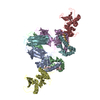
| ||||||||||||||||||||||||||||||||
|---|---|---|---|---|---|---|---|---|---|---|---|---|---|---|---|---|---|---|---|---|---|---|---|---|---|---|---|---|---|---|---|---|---|
| 1 |
| ||||||||||||||||||||||||||||||||
| Unit cell |
| ||||||||||||||||||||||||||||||||
| Noncrystallographic symmetry (NCS) | NCS oper:
| ||||||||||||||||||||||||||||||||
| Details | THE ASYMMETRIC UNIT CONTAINS A DIMER CONSISTING OF TWO HLA/DR-1 AND TWO SEB MOLECULES. THE DEPOSITORS PROVIDED A MONOMER AND THE TRANSFORMATIONS TO GENERATE THE OTHER MONOMER IN THE DIMER. THE PROTEIN DATA BANK GENERATED THE COMPLETE ASYMMETRIC UNIT USING THE TRANSFORMATIONS PROVIDED. CHAINS A, B, C, D WERE DEPOSITED AND CHAINS E, F, G, H WERE GENERATED USING THE TRANSFORMATIONS GIVEN ON MTRIX RECORDS BELOW. SEE REMARK 295 FOR ADDITIONAL DETAILS. |
- Components
Components
| #1: Protein | Mass: 21084.826 Da / Num. of mol.: 2 / Fragment: EXTRACELLULAR DOMAIN Source method: isolated from a genetically manipulated source Source: (gene. exp.)  Homo sapiens (human) / Cell line: LG-2 / Cell line (production host): LG-2 cells / Production host: Homo sapiens (human) / Cell line: LG-2 / Cell line (production host): LG-2 cells / Production host:  Homo sapiens (human) / References: UniProt: P01903 Homo sapiens (human) / References: UniProt: P01903#2: Protein | Mass: 22324.938 Da / Num. of mol.: 2 / Fragment: EXTRACELLULAR DOMAIN Source method: isolated from a genetically manipulated source Source: (gene. exp.)  Homo sapiens (human) / Cell line: LG-2 / Cell line (production host): LG-2 cells / Production host: Homo sapiens (human) / Cell line: LG-2 / Cell line (production host): LG-2 cells / Production host:  Homo sapiens (human) / References: UniProt: P04229, UniProt: P01911*PLUS Homo sapiens (human) / References: UniProt: P04229, UniProt: P01911*PLUS#3: Protein/peptide | Mass: 1124.378 Da / Num. of mol.: 2 / Source method: isolated from a natural source / Details: SUPERPOSITION OF MANY DIFFERENT PEPTIDES / Source: (natural)  Homo sapiens (human) Homo sapiens (human)#4: Protein | Mass: 27793.309 Da / Num. of mol.: 2 / Source method: isolated from a natural source / Source: (natural)  Has protein modification | Y | |
|---|
-Experimental details
-Experiment
| Experiment | Method:  X-RAY DIFFRACTION X-RAY DIFFRACTION |
|---|
- Sample preparation
Sample preparation
| Crystal | Density Matthews: 2.82 Å3/Da / Density % sol: 55 % | ||||||||||||||||||||||||||||||
|---|---|---|---|---|---|---|---|---|---|---|---|---|---|---|---|---|---|---|---|---|---|---|---|---|---|---|---|---|---|---|---|
| Crystal | *PLUS | ||||||||||||||||||||||||||||||
| Crystal grow | *PLUS Temperature: 25 ℃ / pH: 7.5 / Method: vapor diffusion | ||||||||||||||||||||||||||||||
| Components of the solutions | *PLUS
|
-Data collection
| Diffraction source | Source:  SYNCHROTRON / Site: SYNCHROTRON / Site:  CHESS CHESS  / Beamline: F1 / Wavelength: 0.918 / Beamline: F1 / Wavelength: 0.918 |
|---|---|
| Detector | Type: KODAK / Detector: IMAGE PLATE / Date: Nov 1, 1991 |
| Radiation | Monochromatic (M) / Laue (L): M / Scattering type: x-ray |
| Radiation wavelength | Wavelength: 0.918 Å / Relative weight: 1 |
| Reflection | Num. obs: 40627 / % possible obs: 86 % / Redundancy: 3.3 % / Rmerge(I) obs: 0.057 |
| Reflection | *PLUS Highest resolution: 2.7 Å / Lowest resolution: 30 Å |
- Processing
Processing
| Software |
| ||||||||||||||||||||||||||||||||||||||||||||||||||||||||||||
|---|---|---|---|---|---|---|---|---|---|---|---|---|---|---|---|---|---|---|---|---|---|---|---|---|---|---|---|---|---|---|---|---|---|---|---|---|---|---|---|---|---|---|---|---|---|---|---|---|---|---|---|---|---|---|---|---|---|---|---|---|---|
| Refinement | Resolution: 2.7→6 Å / σ(F): 2 Details: THERE IS SOME EVIDENCE THAT THE SECOND SEB MOLECULE IS FOUND AT LOWER OCCUPANCY IN THE LATTICE. THE DR1:SEB STRUCTURE CONTAINS A BACKBONE MODEL (REFINED AS POLYALANINE) FOR ELECTRON DENSITY ...Details: THERE IS SOME EVIDENCE THAT THE SECOND SEB MOLECULE IS FOUND AT LOWER OCCUPANCY IN THE LATTICE. THE DR1:SEB STRUCTURE CONTAINS A BACKBONE MODEL (REFINED AS POLYALANINE) FOR ELECTRON DENSITY THAT CORRESPONDS TO A COMPLEX MIXTURE OF PEPTIDES THAT CO-PURIFY WITH THE HLA-DR1 MOLECULE (SEE REFERENCE 1 ABOVE FOR DETAILS). MHC CLASS II MOLECULES FORM VERY STABLE COMPLEXES WITH PEPTIDES AND, WHEN ISOLATED FROM HUMAN CELL LINES, HLA-DR1 MOLECULES HAVE BEEN SHOWN TO BE LOADED WITH A MIXTURE OF CELLULAR OR SERUM DERIVED PEPTIDES. THE NUMBER OF DIFFERENT PEPTIDES IS ESTIMATED TO BE ON THE ORDER OF THOUSANDS OF DIFFERENT SPECIES. IN THE CO-CRYSTAL OF HLA-DR1 WITH SEB, INTERPRETABLE ELECTRON DENSITY IS OBSERVED FOR THE BACKBONE OF A 13 AMINO ACID PEPTIDE WITH THE HLA-DR1 PEPTIDE-BINDING SITE. ALTHOUGH GOOD SIDE CHAIN DENSITY IS OBSERVED WITHIN THIS REGION, THE ELECTRON DENSITY COULD NOT BE UNAMBIGUOUSLY CORRELATED WITH ANY OF THE SEQUENCES DETERMINED FOR PEPTIDES ELUTED FROM PURIFIED HLA-DR1. THE ELECTRON DENSITY IS CONSISTENT WITH THE SUPERPOSITION OF MANY PEPTIDES WITH DIFFERENT SEQUENCES THAT ASSUME A COMMON CONFORMATION WITHIN THE HLA-DR1 PEPTIDE-BINDING SITE. THE POLYALANINE MODEL, THEREFORE, REPRESENTS A CONSENSUS CONFORMATION FOR PEPTIDE-BINDING TO HLA-DR1. IN THIS ENTRY THIS CHAIN IS PRESENTED AS CHAIN C (AND G) WITH THE RESIDUES NAMED "UNK".
| ||||||||||||||||||||||||||||||||||||||||||||||||||||||||||||
| Refinement step | Cycle: LAST / Resolution: 2.7→6 Å
| ||||||||||||||||||||||||||||||||||||||||||||||||||||||||||||
| Refine LS restraints |
|
 Movie
Movie Controller
Controller


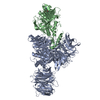
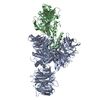
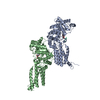
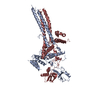
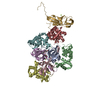
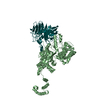
 PDBj
PDBj












